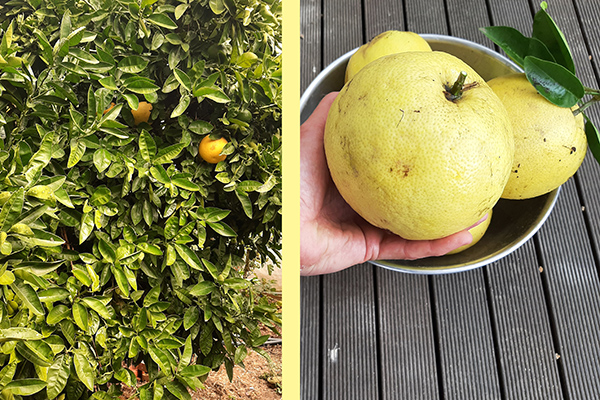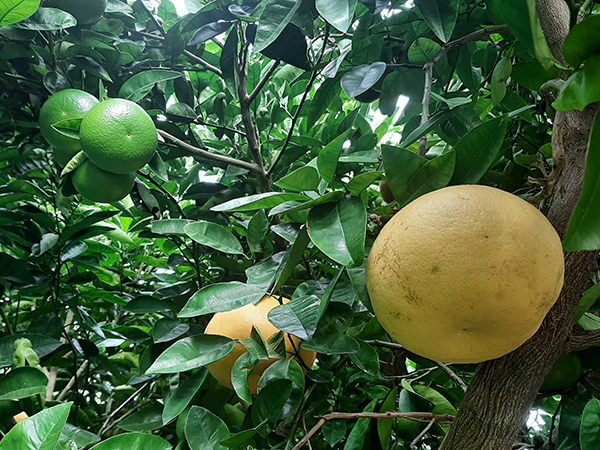The Wheeny grapefruit is a vigorous citrus tree that grows up to five metres and produces exceptionally large grapefruit.
Large tree with glossy, dark green leaves and fragrant, creamy-white blossoms producing large almost seedless fruit with pale flesh and a distinctive tangy flavour.
Grapefruit is a citrus hybrid originating in Barbados. It is an accidental cross between the sweet orange (C. sinensis) and the pomelo, both of which were introduced from Asia in the 17th century. There are many varieties of grapefruit. The Wheeny grapefruit originated as a chance seedling at Wheeny Creek near Kurrajong, New South Wales, Australia, and was named by R. J. Benton, government citrus specialist.
plant information
- CLIMATE SUITABILITY
Subtropical and warm temperate zones. It can also be grown in cool temperate zones in sheltered areas. Can be grown in Ballarat’s climate. - MAXIMUM HEIGHT
2 to 5 metres. Up to 4 metres wide. - FROST TOLERANCE
Can handle frosts to -5 when large. - POLLINATION
Self-pollinating. - LEAF GROWTH
Evergreen. - SUITABILITY FOR POTS
Yes. 35 Litre + pots. - SUNLIGHT REQUIREMENT
Full (80%-100%). - TIME TO FRUIT AND FLOWER
2 to 3 years. - HARVEST MONTHS
July through to October, though mature fruit will sit on the tree most of the year. - WATER REQUIREMENTS
Moderate. - PREFERRED SOIL TYPE
Good Drainage. Soil pH: Neutral (6.6 to 7.3).
Like all citrus varieties Wheeny grapefruit do best when planted in well-drained soil that gets plenty of sunlight and is sheltered from strong winds. See Planting Citrus Trees for planting information.
Citrus trees are heavy feeders, requiring lots of rich organic composted matter to produce a tree ladened with juicy fruit. They also need a fertiliser high in nitrogen with fertiliser additives that contain all the nutrients and trace elements needed for strong growth. Suitable fertilisers include:-
- CHICKEN MANURE
Very high in nitrogen. - DYNAMIC LIFTER
Pelletised chicken manure that is high in nitrogen. - BLACK MARVEL FRUIT & CITRUS FOOD
Apply as directed by the instructions on the package. - UREA
Soluble nitrogen. EPSOM SALTS (MAGNESIUM SULPHATE)
Australian soils are low in Magnesium sulphate and citrus trees need it to thrive.
Fertilise every four to six weeks during the growing season or as directed by the instructions on fertilser bags.
- PRUNE AFTER THE RISK OF A HEAVY FROST HAS PASSED IN EARLY SPRING
A second pruning can be done at the end of Summer or early autumn. - REMOVE EXCESSIVE SHOOTS AND DEAD OR SAGGING BRANCHES
- PRUNE THE OUTER BRANCHES TO THE HEIGHT AND SHAPE THAT YOU WANT
But no more than 20% of the trees foliage should be pruned at any one time. The outer small branches can be removed using garden sheers or a hedge trimmer.
The main pests of all citrus varieties are mealy bugs, (small, white, furry looking insects that are sticky to touch), scale and aphids, all of which are sap sucking insects. The sugary substance they excrete discolours the leaves with a black sooty mould, which impedes the ability of the leaves to photosynthesize. Spraying with white oil and pyrethrum will usually control these sap sucking insects, though you will usually have to spray two or three times.
Another citrus pest is the citrus gall wasp. This insect lays its eggs in the branch, which swells so the hatching insect can get food. To control gall wasp, prune the gall out and get rid of it before September, when the adult hatches.
Queensland fruit fly is also a serious pest for citrus trees in areas where fruit flies are active.
Regular pruning of citrus trees will yield more and bigger fruit, prevent damaged and diseased wood, and help maintain the size of and shape the trees.
My Wheeny grapefruit is the largest and most vigorous of my citrus trees. It easily handles the severest Ballarat frosts. I give it minimal water, yet it constantly produces a heavy crop of extremely large juicy grapefruit, much larger than the average grapefruit sold in shops. While officially Wheeny grapefruit trees produce fruit from July through October the ripe grapefruit hangs on my tree for an extended period of time, so that I still have ripe grapefruit on the trees when the new season’s grapefruit are beginning to ripen. The fruit can be so numerous that in some seasons I have to thin the fruit to avoid branches breaking under the sheer weight of the fruit.

LEFT: My Wheeny grapefruit tree in mid-May (late Autumn), it still has fruit on it from the previous winter. RIGHT: some of the harvested fruit, showing how big they get.

LEFT: New season’s fruit growing on the tree (May). RIGHT: Last season’s ripe fruit still on the tree. The combination of a staggered flowering and a tendency for the ripe fruit to hang on the tree for an extended period of time means that a Wheeny grapefruit produces fruit all year round.




